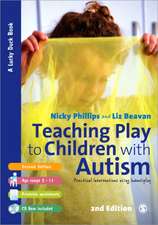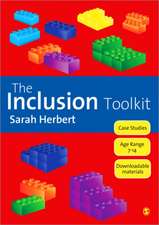Guiding Change in Special Education: How to Help Schools With New Ideas and Practices
Autor Ronald G. Havelock, James L. Hamiltonen Limba Engleză Paperback – 20 ian 2004
| Toate formatele și edițiile | Preț | Express |
|---|---|---|
| Paperback (1) | 346.10 lei 6-8 săpt. | |
| SAGE Publications – 20 ian 2004 | 346.10 lei 6-8 săpt. | |
| Hardback (1) | 606.87 lei 6-8 săpt. | |
| SAGE Publications – 20 ian 2004 | 606.87 lei 6-8 săpt. |
Preț: 346.10 lei
Nou
Puncte Express: 519
Preț estimativ în valută:
66.23€ • 71.92$ • 55.64£
66.23€ • 71.92$ • 55.64£
Carte tipărită la comandă
Livrare economică 22 aprilie-06 mai
Preluare comenzi: 021 569.72.76
Specificații
ISBN-13: 9780761939658
ISBN-10: 0761939652
Pagini: 296
Dimensiuni: 216 x 279 x 17 mm
Greutate: 0.69 kg
Ediția:New.
Editura: SAGE Publications
Colecția Corwin
Locul publicării:Thousand Oaks, United States
ISBN-10: 0761939652
Pagini: 296
Dimensiuni: 216 x 279 x 17 mm
Greutate: 0.69 kg
Ediția:New.
Editura: SAGE Publications
Colecția Corwin
Locul publicării:Thousand Oaks, United States
Cuprins
Foreword - Maurice McInerney
Acknowledgments
About the Authors
Introduction
Case Study
Stage 1. Care: Establishing the Need for Action
Someone Must Care Enough to Make It All Worthwhile
A Three-Step Model of Change: Unfreeze-Move-Refreeze
How School Systems Show (and Don't Show) That They Are in Trouble
Inside Versus Outside Forces
Linking Agent as Connector and Orchestrator of Forces
Whose Responsibility? The Value Issues in Helping
Care: Summary
Stage 2. Relate: Building a Relationship
Build a Good Relationship With the People You Are Trying to Help
Diagram Your School or School District as a Social Network
Linker Configurations
How to Size Up Your Relationship
Final Word on Relationship Building
Relate: Summary
Stage 3. Examine: Understanding the Problem
Turn Cares Into Problems You Can Solve
Making a Good Diagnosis
The Data Collection Phase
The Analytic Phase
Making a Diagnostic Inventory
Systemic Analysis: Understanding the System
A Data Collection Process
A Set of Rating Dimensions
Creating a Diagnostic Matrix/Checklist That Points to Solutions
Integrating Diagnosis With the Other Stages
Examine: Summary
Stage 4. Acquire: Seeking and Finding Relevant Resources
The Money Theory of Change
The People Theory of Change
The Knowledge Theory of Change
Acquiring Materials (= Packaged Knowledge)
Acquire: Summary
Stage 5. Try: Moving From Knowledge to Action
Giving a Fair Trial to a Well-Considered Solution
Pretrial Feasibility Testing: Comparing and Selecting the Best
Plan the Implementation
What Is the Process?
How Can You Evaluate Process?
What Are the Outcomes?
Can You Measure Outcomes?
Cautions on Evaluation
Using the Results
Sharing With Your Team
Try: Summary
Stage 6. Extend: Gaining Deeper and Wider Acceptance
Issues About Adoption and Diffusion
Solidifying Adoption at the Trial Site (Keeping Going)
Expanding Change at the Trial Site
Extending the Trial to Proximate Sites (Follow-On Adoption)
Extending Adoption to the Larger System
Variations of the Adoption Curve
Going Wider: Strategies and Tactics (The Second Stage of Diffusion)
Extend: Summary
Stage 7. Renew: Encouraging Ongoing Change
How Do Systems Absorb Changes?
Improve the Process
Keep the Change Fresh
Create a Self-Renewal Capacity
From Item Change to System Change
Installing the Change Function
Terminating and Moving On
Renew: Summary
Summary and Synthesis
References
Index
Acknowledgments
About the Authors
Introduction
Case Study
Stage 1. Care: Establishing the Need for Action
Someone Must Care Enough to Make It All Worthwhile
A Three-Step Model of Change: Unfreeze-Move-Refreeze
How School Systems Show (and Don't Show) That They Are in Trouble
Inside Versus Outside Forces
Linking Agent as Connector and Orchestrator of Forces
Whose Responsibility? The Value Issues in Helping
Care: Summary
Stage 2. Relate: Building a Relationship
Build a Good Relationship With the People You Are Trying to Help
Diagram Your School or School District as a Social Network
Linker Configurations
How to Size Up Your Relationship
Final Word on Relationship Building
Relate: Summary
Stage 3. Examine: Understanding the Problem
Turn Cares Into Problems You Can Solve
Making a Good Diagnosis
The Data Collection Phase
The Analytic Phase
Making a Diagnostic Inventory
Systemic Analysis: Understanding the System
A Data Collection Process
A Set of Rating Dimensions
Creating a Diagnostic Matrix/Checklist That Points to Solutions
Integrating Diagnosis With the Other Stages
Examine: Summary
Stage 4. Acquire: Seeking and Finding Relevant Resources
The Money Theory of Change
The People Theory of Change
The Knowledge Theory of Change
Acquiring Materials (= Packaged Knowledge)
Acquire: Summary
Stage 5. Try: Moving From Knowledge to Action
Giving a Fair Trial to a Well-Considered Solution
Pretrial Feasibility Testing: Comparing and Selecting the Best
Plan the Implementation
What Is the Process?
How Can You Evaluate Process?
What Are the Outcomes?
Can You Measure Outcomes?
Cautions on Evaluation
Using the Results
Sharing With Your Team
Try: Summary
Stage 6. Extend: Gaining Deeper and Wider Acceptance
Issues About Adoption and Diffusion
Solidifying Adoption at the Trial Site (Keeping Going)
Expanding Change at the Trial Site
Extending the Trial to Proximate Sites (Follow-On Adoption)
Extending Adoption to the Larger System
Variations of the Adoption Curve
Going Wider: Strategies and Tactics (The Second Stage of Diffusion)
Extend: Summary
Stage 7. Renew: Encouraging Ongoing Change
How Do Systems Absorb Changes?
Improve the Process
Keep the Change Fresh
Create a Self-Renewal Capacity
From Item Change to System Change
Installing the Change Function
Terminating and Moving On
Renew: Summary
Summary and Synthesis
References
Index
Notă biografică
Descriere
This practical, step-by-step guide illustrates and describes the seven stages of school change and provides explanations and advice for incorporating each stage into your change process.
















